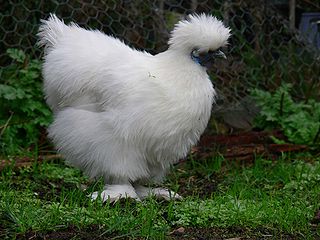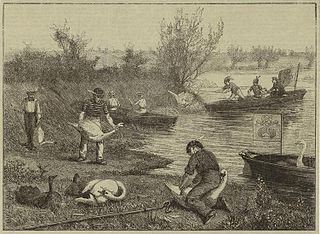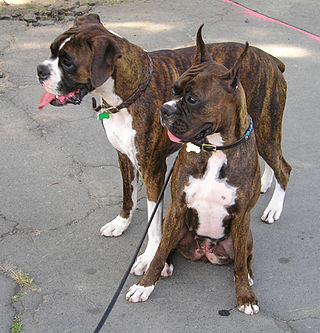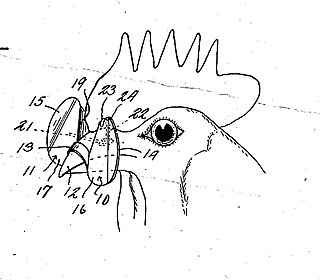

Dubbing is the procedure of removing the comb, wattles and sometimes earlobes of poultry. Removing the wattles is sometimes called "dewattling".


Dubbing is the procedure of removing the comb, wattles and sometimes earlobes of poultry. Removing the wattles is sometimes called "dewattling".
To perform dubbing, the tissues are first disinfected and, if available, an anesthetic is applied to limit pain. Sterile scissors or dubbing shears are used to cut the tissues off, and a styptic, an astringent chemical that reduces bleeding, is applied. The wounds are left uncovered. Some recommend dubbing should be done on day-old chicks whilst others advise waiting until the bird's comb is more developed. [1] [2]
Dubbing is sometimes performed to limit damage caused by injury or frostbite. Dubbing for some breeds has become a tradition and is required for some birds to meet breed-specifications. [3] Other reasons include removing combs which have become so large they prevent the bird from taking food into its mouth or making the head so heavy it sinks into the bird's chest. [4]
In the US, the National Chicken Council (2003) listed dubbing of cockerels as one of the acceptable procedures that may cause short-term stress but which are necessary for the long-term welfare of the flock. [5] Dubbing is also performed to prevent injuries from other birds or while being kept in pens.
In practice, an anesthetic is rarely used during dubbing and as a consequence, the RSPCA Australia is opposed to dubbing on poultry intended to be exhibited at shows, and describes the practice as a cause of pain and distress. [6] The comb and wattles function in thermoregulation; blood circulating from the comb and the wattles helps the bird lose heat during hot weather. The comb is also used in mate-assessment in some poultry species. [7] Dubbing would interfere with both these functions of the comb and wattles.
In commercial laying hens, those dubbed at hatching exhibit few effects on egg production, but the older the birds are when dubbed, the greater the negative effects of dubbing. [8]
In the UK, the Farm Animal Welfare Council (FAWC) concludes "that removal of the comb offers no welfare advantages to offset the disturbance caused by the procedure and believe the practice should be phased out." [9] The Department for the Environment, Food and Rural Affairs (Defra) writes: "Removal of the comb offers few, if any, welfare advantages in comparison with the disturbance and pain likely to be caused and should be avoided." [10] The Veterinary Surgeons Act 1966 (Schedule 3 Amendment) Order 1988 (SI 1988 No. 526) permits only a veterinary surgeon to remove the combs of a domestic fowl which has reached the age of 72 hours.
In New Zealand, the National Animal Welfare Advisory Committee stated in 2002 they were "working towards a strategy to prevent this practice." [11]
In 2010, the European Food Safety Authority (EFSA) reviewed scientific evidence and concluded "that no mutilation with an effect on welfare as severe as those resulting from cutting off toes or dubbing the comb should be carried out unless justified by evidence for a substantial and unavoidable level of poor welfare in the birds themselves and other birds." [12]

Poultry are domesticated birds kept by humans for the purpose of harvesting useful animal products such as meat, eggs or feathers, and the practice of raising poultry is known as poultry farming. These birds are most typically members of the superorder Galloanserae (fowl), especially the order Galliformes. The term also includes waterfowls of the family Anatidae and other flying birds that are kept and killed for their meat such as the young pigeons, but does not include wild birds hunted for food known as game or quarry.

Debeaking, beak trimming, or beak conditioning is the partial removal of the beak of poultry, especially layer hens and turkeys although it may also be performed on quail and ducks. Most commonly, the beak is shortened permanently, although regrowth can occur. The trimmed lower beak is somewhat longer than the upper beak. A similar but separate practice, usually performed by an avian veterinarian or an experienced birdkeeper, involves clipping, filing or sanding the beaks of captive birds for health purposes – in order to correct or temporarily to alleviate overgrowths or deformities and better allow the bird to go about its normal feeding and preening activities. Amongst raptor-keepers, this practice is commonly known as "coping".

The American Game is an American breed of game fowl, chickens bred specifically for cockfighting. It has many color varieties, and may also be kept for ornament.

The Silkie is a breed of chicken named for its atypically fluffy plumage, which is said to feel like silk and satin. The breed has several other unusual qualities, such as black skin and bones, blue earlobes, and five toes on each foot, whereas most chickens only have four. They are often exhibited in poultry shows, and also appear in various colors. In addition to their distinctive physical characteristics, Silkies are well known for their calm and friendly temperament. It is among the most docile of poultry. Hens are also exceptionally broody, and care for young well. Although they are fair layers themselves, laying only about three eggs a week, they are commonly used to hatch eggs from other breeds and bird species due to their broody nature. Silky chickens have been bred to have many colors consisting of 1.Black 2.Blue 3.Buff 4.Partridge 5.Splash 6.White 7.Lavender 8.Paint 9.Porcelain

A capon is a male chicken that has been castrated or neutered, either physically or chemically, to improve the quality of its flesh for food, and, in some countries like Spain, fattened by forced feeding.
Exsanguination is death caused by loss of blood. Depending upon the health of the individual, people usually die from losing half to two-thirds of their blood; a loss of roughly one-third of the blood volume is considered very serious. Even a single deep cut can warrant suturing and hospitalization, especially if trauma, a vein or artery, or another comorbidity is involved. The word comes from the Latin 'sanguis', meaning blood.

A comb is a fleshy growth or crest on the top of the head of some gallinaceous birds, such as domestic chickens. The alternative name cockscomb reflects the fact that combs are generally larger on cock birds than on hens. The comb is one of several fleshy protuberances on the heads of chickens, the others being the wattles and earlobes, which collectively are called caruncles. In turkeys, the caruncles are the fleshy nodules on the head and throat.

Forced molting, sometimes known as induced molting, is the practice by some poultry industries of artificially provoking a flock to molt simultaneously, typically by withdrawing food for 7–14 days and sometimes also withdrawing water for an extended period. Forced molting is usually implemented when egg-production is naturally decreasing toward the end of the first egg-laying phase. During the forced molt, the birds cease producing eggs for at least two weeks, which allows the bird's reproductive tracts to regress and rejuvenate. After the molt, the hen's egg production rate usually peaks slightly lower than the previous peak, but egg quality is improved. The purpose of forced molting is therefore to increase egg production, egg quality, and profitability of flocks in their second or subsequent laying phases, by not allowing the hen's body the necessary time to rejuvenate during the natural cycle of feather replenishment.

Pinioning is the act of surgically removing one pinion joint, the joint of a bird's wing farthest from the body, to prevent flight. Pinioning is often done to waterfowl and poultry. It is not typically done to companion bird species such as parrots. This practice is unnecessary and restricted in many countries.
In Islamic law, dhabīḥah, also spelled zabiha, is the prescribed method of slaughter for halal animals. It consists of a swift, deep incision to the throat with a very sharp knife, cutting the wind pipe, jugular veins and carotid arteries on both sides but leaving the spinal cord intact. The butcher is also required to call upon the name of Allah (Bismillah) individually for each animal.
Docking is the intentional removal of part of an animal's tail or, sometimes, ears. The term cropping is more commonly used in reference to the cropping of ears, while docking more commonly—but not exclusively—refers to the tail; the term tailing is used, also. The term has its origins in the living flesh of the tail, commonly known as the dock, from which the animal's tail hairs grow.

Poultry farming is the form of animal husbandry which raises domesticated birds such as chickens, ducks, turkeys and geese to produce meat or eggs for food. Poultry – mostly chickens – are farmed in great numbers. More than 60 billion chickens are killed for consumption annually. Chickens raised for eggs are known as layers, while chickens raised for meat are called broilers.

The Modern Game is a breed of ornamental chicken which originated in England between 1850 and 1900. Purely an exhibition bird, Modern Game were developed to be most aesthetically pleasing and to epitomize the visual appeal of the gamecock or fighting cock.

The Rhode Island White is a breed of chicken originating in the U.S. state of Rhode Island. Despite their very similar names and shared place of origin, the Rhode Island White is a distinct breed from the Rhode Island Red. However, Rhode Island Reds and Whites can be bred together to create Red Sex-Link hybrid chickens, such as the ISA Brown. In Australia, the Rhode Island White is regarded as a color variety of the Rhode Island breed according to the Australian Poultry Standards.

Feather pecking is a behavioural problem that occurs most frequently amongst domestic hens reared for egg production, although it does occur in other poultry such as pheasants, turkeys, ducks, broiler chickens and is sometimes seen in farmed ostriches. Feather pecking occurs when one bird repeatedly pecks at the feathers of another. The levels of severity may be recognized as mild and severe. Gentle feather pecking is considered to be a normal investigatory behaviour where the feathers of the recipient are hardly disturbed and therefore does not represent a problem. In severe feather pecking, however, the feathers of the recipient are grasped, pulled at and sometimes removed. This is painful for the receiving bird and can lead to trauma of the skin or bleeding, which in turn can lead to cannibalism and death.

Numerous procedures performed on domestic animals are usually more invasive than purely cosmetic alterations, but differ from types of veterinary surgery that are performed exclusively for urgent health reasons. Such procedures have been grouped together under the technical term 'mutilatory' by the Royal College of Veterinary Surgeons in a report describing the reasons for their being conducted and their welfare consequences, and by others.

Blinders, also known as peepers, are devices fitted to, or through, the beaks of poultry to block their forward vision and assist in the control of feather pecking, cannibalism and sometimes egg-eating. A patent for the devices was filed as early as 1935. They are used primarily for game birds, pheasant and quail, but also for turkeys and laying hens. Blinders are opaque and prevent forward vision, unlike similar devices called spectacles which have transparent lenses. Blinders work by reducing the accuracy of pecking at the feathers or body of another bird, rather than spectacles which have coloured lenses and allow the bird to see forwards but alter the perceived colour, particularly of blood. Blinders are held in position with a circlip arrangement or lugs into the nares of the bird, or a pin which pierces through the nasal septum. They can be made of metal (aluminium), neoprene or plastic, and are often brightly coloured making it easy to identify birds which have lost the device. Some versions have a hole in the centre of each of the blinders, thereby allowing restricted forward vision.
The Oxford Old English Game is an ancient breed of chicken, originating from Britain. They were officially recognised when The Old English Game Club split, creating two breeds of Old English Game fowl. They are primarily farmed for meat but have been used for cock fighting and eggs on a domestic scale.

Christopher M. Sherwin was an English veterinary scientist and senior research fellow at the University of Bristol Veterinary School in Lower Langford, Somerset. He specialised in applied ethology, the study of the behaviour of animals in the context of their interactions with humans, and of how to balance the animals' needs with the demands placed on them by humans.

Nettie Metcalf was an American farmer from Warren, Ohio. She is best known for creating the Buckeye chicken breed, which was officiated by the American Poultry Association in February 1905. Metcalf attended poultry meetings across North America and became President of the American Buckeye Club. She is the only woman recorded by the American Poultry Association to create a chicken breed.